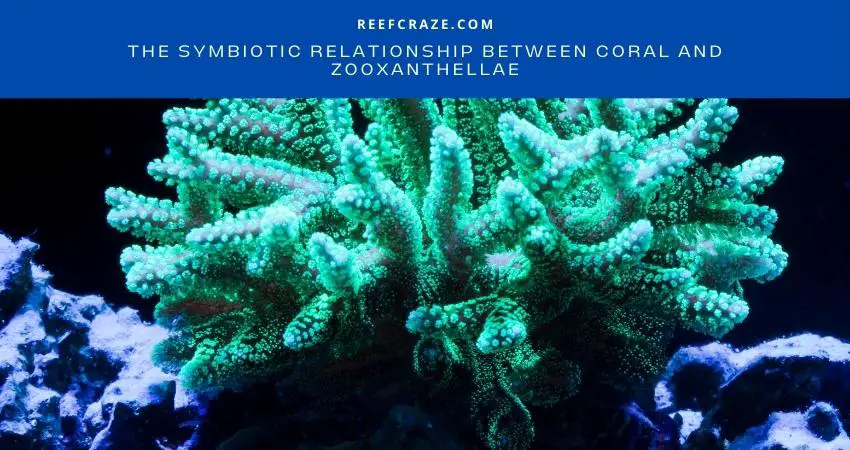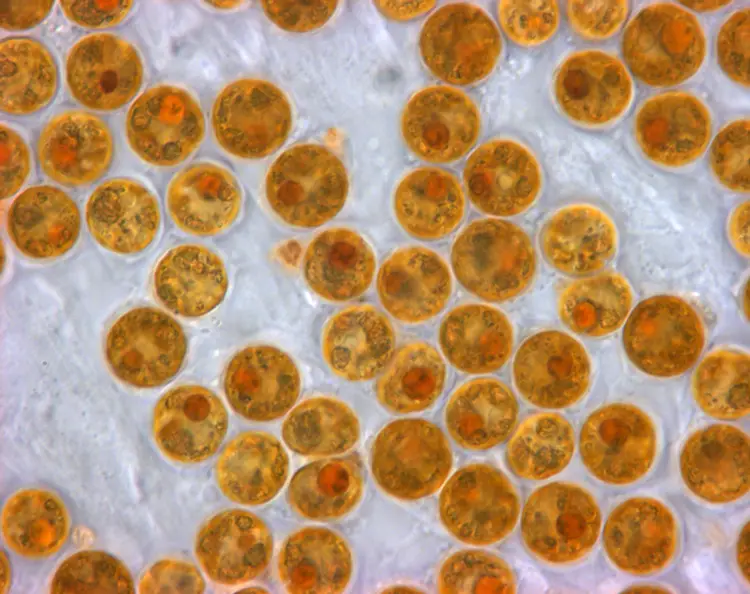Having a coral reef tank requires you to have knowledge about a lot of things other than managing the reef tank and the corals. You may have or will have heard of the term zooxanthellae if you talk or have talked about reefing with experienced reefers. Zooxanthellae, a type of photosynthesis algae, are plant cells living in the tissues of your coral polyps.
There is a mutualistic, symbiotic relationship between coral and zooxanthellae. Corals generate water and carbon dioxide, byproducts of their cellular respiration. In return, zooxanthellae use those two components to perform photosynthesis.
Yes, corals maintain a pretty significant relationship with their buddies, out of which both get something in return. I will talk broadly about them in the imminent sections. Stay tuned!

The Symbiotic Relationship Between Coral And Zooxanthellae
As stated by a study conducted by a group of researchers from Princeton University, the mutual relationship between corals and algae started millions of years ago. In their mutualistic relationship, one provides the other with shelter in exchange for vivid colors and supplies of nutrients. The interconnection is a fundamental element for coral reef health, responsible for the habitat of 25% of marine life.
Reef-building corals usually possess photosynthetic algae named zooxanthellae. They share a mutualistic relationship in which corals provide the necessary components for photosynthesis and a safe environment for the algae. In exchange, zooxanthellae produce oxygen and assist corals in removing wastes.
Most crucially, zooxanthellae supply glucose, amino acids, and glycerol to corals. These are their photosynthesis products. Corals take them in to produce carbs, calcium carbonate, fats, and proteins.

The relationship between these two facilitates strict nutrient recycling in the water. More than 90% of organic compounds zooxanthellae photosynthetically produce go to the corals’ tissues. It is the driving factor behind the productivity and growth of corals.
Besides providing essential nutrients, zooxanthellae are also the reason behind the unique and exotic colors of corals. Your corals will look vibrant as long as they have their plant buddies inside their tissues. If they are gone, their colors will fade, and the corals will experience coral bleaching.
Due to this close connection with zooxanthellae, most reef-building corals often respond like plants to the water environment. They need clean water for survival so that their algae get enough sunlight for photosynthesis.
That is why you will usually find them in waters having few suspended materials, low productivity, and low turbidity. Interestingly, it creates a paradox – corals require nutrient-poor, clean water while they belong to the most diverse and productive marine environments.
Is It Possible For Corals To Survive Without Zooxanthellae?
If the bleaching is not highly severe, the small number of the remaining zooxanthellae in coral tissues can repopulate and help the coral get its usual color. It will take weeks to months.
However, branching corals usually cannot live for more than one and a half weeks without zooxanthellae.
How Do Zooxanthellae Cope With The Environment Around Them?
Some corals can spontaneously cope with coral bleaching using their natural protection mechanism. They produce a fluorescent pigment that acts like sunblock, which builds a shield in the coral tissues covering the zooxanthellae to protect them from UV rays.
Do Zooxanthellae Leave Their Corals?
They do when corals make them, yes. When the temperature is scorching, corals stress out and expel their algae. As the algae get out, corals start to lose their color. This event is called coral bleaching.
If the weather does not change within several days, corals will die because of preventing the algae from coming back.
Here is an intriguing piece of information discovered by researchers Muller-Parker and their team: corals do not necessarily contain the same zooxanthellae all the time. If a coral expels its plant buddies during bleaching and survives, it can get a different species of zooxanthellae.
What Are The Reasons For Coral Bleaching Inside Reef Tanks?
Coral bleaching occurs due to critical changes in salinity, light intensity, temperature, bacteria, malnutrition, lack of water movements, physical damage, stress-inducing chemicals, or viruses. Excess nutrients can also trigger the situation by making zooxanthellae mushroom and causing frequent expulsion where environmental stressors (i.e., excess temperature) are present.
How Can I Avoid Coral Bleaching?
You can follow the following four things:
- When the water temperature goes higher than 80 degrees Fahrenheit, turn off the lights until the temperature lowers.
- Acclimate your new corals to the tank slowly, especially if it has intense lighting.
- Keep the levels of phosphate and nitrate under control. It is healthy for your corals if the water has some nutrients. But excess nutrients cause excessive zooxanthellae, which, as we have already discussed, you would not want.
- Keep the water parameters slow: drastic changes in pH, temperatures, and salinity can trigger a bleaching event.
Is It Possible To Save A Bleached Coral From Dying?
It is if it is not too late. A bleached coral is very vulnerable to infections and unable to fulfill its nutritional needs. That will cause it to die if you do not take care of it beforehand.
Have You Identified And Removed The Stressor?
- Lighting: If you have changed the lighting position or the coral’s position in the tank, you should dim the lights or move your coral to somewhere with less lighting and more shade.
- Water Contaminants: You have to intervene ASAP if the tank has rapid contamination. You have to change at least 1/5th of your tank water to eliminate the contaminants. If possible, try to relocate your corals to a new tank with contaminant-free water.
- Water Parameters: Changing the water several times will change the parameters back to their required level if they increase to an intolerable level.
After making the necessary changes, you have to keep your corals alive until the zooxanthellae come back. Here is what you can do about that:
- Fulfill the nutritional needs of your corals by feeding them directly. There will be a caloric deficiency due to the absence of the zooxanthellae. You need to make that up by giving them food. Provide your corals with food from once to thrice each week. Observe the parameters closely during the time as feeding frequently can cause the nutrients to scale up.
- Ensure that the water flow is sufficient to minimize algae growth and infection. The indirect results of a bleaching event are that corals cannot defend themselves naturally from algae growth or infection. So, it is essential that they get sufficient water flow to remove encroaching algae immediately.
Since bleaching induces stress, it will leave the corals prone to infection, tissue loss, and starvation. But you can undo the impact by removing the underlying tissues and nursing their health back with proper care.
Final Words
So, I have explained the relationship between corals and zooxanthellae. Crazy to think that all the lighting and water parameters you strictly manage and maintain are more for the tiny fellas than for your corals, isn’t it?
But it’s true. The lively colors of your corals that lighten up your reef tank are because of the zooxan population inside their tissues. As long as you take care of them, they will keep your corals healthy. Hopefully, the article provided you with sufficient insights about that.
